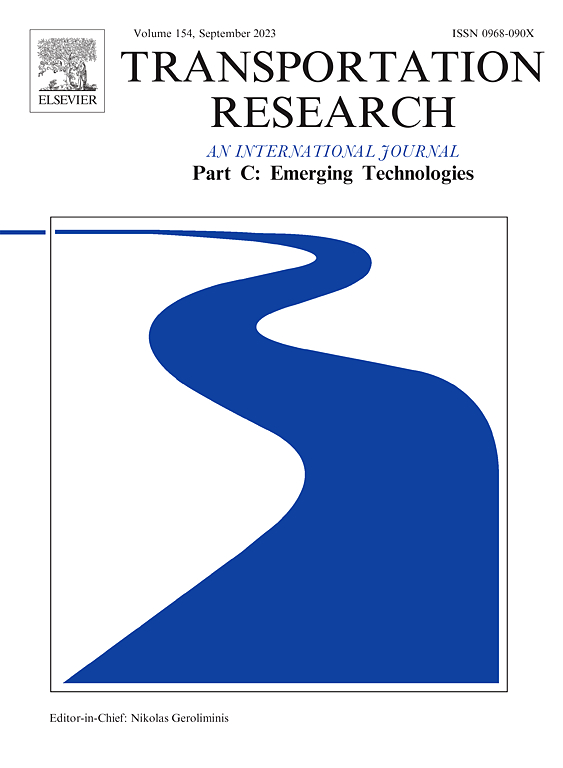基于分层协同运动规划框架的实时可执行排编队方法
IF 7.6
1区 工程技术
Q1 TRANSPORTATION SCIENCE & TECHNOLOGY
Transportation Research Part C-Emerging Technologies
Pub Date : 2024-11-29
DOI:10.1016/j.trc.2024.104942
引用次数: 0
摘要
虽然联网和自动驾驶汽车(CAV)队列有望提高交通效率和降低能耗,但由于存在重大的计算和控制挑战,我们仍然缺乏有效的算法来指导CAV在道路上的局部运动以形成队列。本研究通过设计一个实时可执行的分层递归排编队(HR-PF)框架来解决这一问题,该框架针对混合流交通条件,包括人类驾驶车辆(HDV)和自动驾驶汽车(cav)。HR-PF框架包括三个层次数学模型(模块),旨在在考虑宏观交通状况和微观交通安全的同时优化排编队。模块i通过一个混合整数二次规划来确定排的形成时间、位置和状态。进一步将其推广为一个混合整数非线性规划,使我们也可以选择目标排的最优规模。模块ii设计了一个混合状态-点阵运动规划器,为自动驾驶汽车生成最优轨迹参考,以接近目标队列状态,确保微观交通安全。模块iii开发纵向和横向控制器,使自动驾驶汽车能够准确跟踪轨迹参考。这些模型以不同的频率递归地运行,以平衡数学严谨性和实际应用。数值实验表明,在保持交通效率的同时,HR-PF可以在不同的交通场景和道路几何形状下实时有效地形成队列。此外,组队性能受周边交通密度和自动驾驶汽车穿透率的影响,在LOS C和D交通环境下可以快速组队,而在LOS E和f交通环境下的影响略大。这些研究结果为探索复杂交通环境下自动驾驶汽车的先进组队和排队策略提供了有力的支持。本文章由计算机程序翻译,如有差异,请以英文原文为准。
Real-time executable platoon formation approach using hierarchical cooperative motion planning framework
While connected and automated vehicle (CAV) platooning holds promise for enhancing traffic efficiency and reducing energy consumption, we still lack efficient algorithms for guiding the local movements of CAVs to form a platoon on a road due to significant computational and control challenges. This study addresses this gap by designing a real-time executable Hierarchical and Recursive Platoon Formation (HR-PF) framework tailored to mixed flow traffic conditions that encompass both Human-Driven Vehicles (HDV) and CAVs. The HR-PF framework comprises three hierarchical mathematical models (modules) designed to optimize platoon formation while considering both macroscopic traffic conditions and microscopic traffic safety. Module-I formulates a mixed integer quadratic program to determine the timing, location, and state of platoon formation. It is further extended to a mixed integer nonlinear program so that we can also select the optimal size of the target platoon. Module-II designs a Hybrid State-Lattice Motion planner to generate optimal trajectory references for CAVs to approach the target platoon state, ensuring microscopic traffic safety. Module-III develops longitudinal and lateral controllers to enable CAVs to track trajectory references accurately. These models function recursively at varying frequencies to balance mathematical rigor with practical application. Numerical experiments demonstrate that HR-PF facilitates efficient platoon formation in real-time across diverse traffic scenarios and road geometries while sustaining traffic efficiency. Furthermore, the performance of platoon formation is affected by surrounding traffic density and CAV penetrations, with prompt formation observed under LOS C and D traffic environments and slightly more traffic impacts under LOS E and F. These findings provide robust support for exploring advanced platoon formation and platooning strategies for CAVs under complicated traffic environments.
求助全文
通过发布文献求助,成功后即可免费获取论文全文。
去求助
来源期刊
CiteScore
15.80
自引率
12.00%
发文量
332
审稿时长
64 days
期刊介绍:
Transportation Research: Part C (TR_C) is dedicated to showcasing high-quality, scholarly research that delves into the development, applications, and implications of transportation systems and emerging technologies. Our focus lies not solely on individual technologies, but rather on their broader implications for the planning, design, operation, control, maintenance, and rehabilitation of transportation systems, services, and components. In essence, the intellectual core of the journal revolves around the transportation aspect rather than the technology itself. We actively encourage the integration of quantitative methods from diverse fields such as operations research, control systems, complex networks, computer science, and artificial intelligence. Join us in exploring the intersection of transportation systems and emerging technologies to drive innovation and progress in the field.

 求助内容:
求助内容: 应助结果提醒方式:
应助结果提醒方式:


